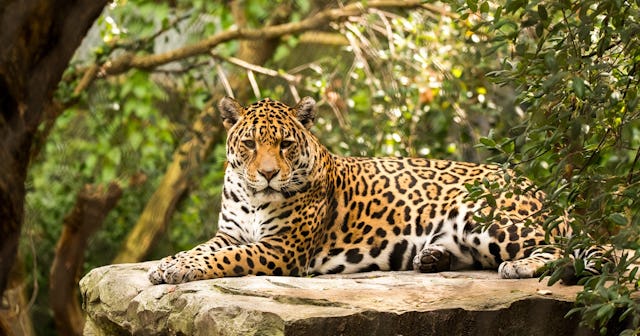These 11 Rad And Regal Leopard Coloring Pages Are Totally Spot On

How much leopard print do you own? How much have you bought for your mini? These days, leopard print is practically a neutral color, and you can find it on anything: sneakers, water bottles, and even kitchen utensils. We love leopard print. But what do we actually know about leopards? And how do we make “loves leopard print” into a kids’ hobby? We could probably start with leopard coloring pages.
We know the argument: Leopards all look the same, so what is there to color? Says who, Boo Boo? Leopards can be any color you want. Just ask Lisa Frank. Coloring these leopards and practicing staying inside the lines will work wonders for your kiddos’ kindergarten readiness, helping with focus and self-regulation. The educational activity doesn’t have to end there, either. As your child explores fun new leopard colors or fills out the background for these leopards, they’re also taking the first step in imaginative play. Plus, we pulled some pretty interesting facts about leopards to share along the way. It might just help you turn your leopard print obsession into a leopard-loving hobby.
On the prowl for more coloring fun? We’re awash with coloring activities. We have flower coloring pages that won’t bother your allergies and unicorn coloring pages for your little dreamer. Your future astronaut might like rockin’ rockets or star coloring pages. Or, if you want to keep your afternoon in the big cat family, you can sink your claws into our lion coloring pages, tiger coloring pages, and cheetah coloring pages.
Free Leopard Coloring Pages
Leopard Page No. 1
As you’ll undoubtedly notice, these slinky members of the Panthera genus sport distinctive coats. While their spots are among the attributes that make leopards unique among big cats, there are plenty more.
Leopard Page No. 2
Leopards are pretty adaptable creatures. They can live in all kinds of climates, from deserts and forests to mountains and swamps. They’re so adaptable, in fact, that they can be found almost anywhere and have habitats all over the world. You could call them the most traveled of the big cats.
Leopard Page No. 3
While leopards are certainly much larger than your average house cat, they’re not giants. They can weigh between 50 to 70 pounds, roughly the weight of a golden retriever. They also all stand right around two feet tall at the shoulder.
Leopard Page No. 4
Don’t let their seemingly approachable size fool you, though. Leopards were made to hunt, capable of running at a max speed of 36 miles per hour. So, uh, good luck outrunning one!
Leopard Page No. 5
Leopards can also leap incredible distances — their vertical jump can hit heights of about ten feet. And their leaps forward are even more impressive, averaging 20 feet in length.
Leopard Page No. 6
What could they possibly use all those athletic skills for? Hunting, of course! Leopards are carnivorous, which means they eat and survive on meat only. Sounds good… but we’d really miss queso.
Leopard Page No. 7
Why the spots? Spots help leopards blend in and hide in almost any situation, which is another helpful trait to have while hunting. Since leopards are primarily nocturnal and hunt at night, those dark spots are especially beneficial.
Leopard Page No. 8
Leopards aren’t without predators, though. They hunt at night to avoid run-ins with bigger or meaner animals that would treat them like a nice snack. Leopards are often prey for lions, tigers, and hyenas.
Leopard Page No. 9
Remember looking forward to turning 16 and getting your license? Most leopards are nearing the end of their lives at that stage — they typically only live to be 12 to 17 years old in the wild. Leopards in captivity at zoos, however, usually live up to 23 years old.
Leopard Page No. 10
There are, however, exceptions to that average! Ivory, a captive black panther, is in the Guinness Book of World Records as the oldest captive panther. He was 26 in 2016. And did you know some people have reported spotting the mysterious North American black panther in the United States? No one has ever photographed it, but some scientists believe it could be a black cougar or mountain lion!
Leopard Page No. 11
leopard-coloring-page-11
Move over Simba, there’s a new king of the jungle! This leopard looks like royalty, and besides being absolutely beautiful, leopards are also excellent climbers. They can carry their prey up trees to protect their food from scavengers. In fact, leopards can even sleep up there. They can also hunt from trees by using their spots to blend in and pounce from deadly heights.
Click here to print all of the leopard coloring pages at once!
This article was originally published on